- Регистрация
- 17 Февраль 2018
- Сообщения
- 38 906
- Лучшие ответы
- 0
- Реакции
- 0
- Баллы
- 2 093
Offline
More TOPS, more cores, more challenges to lead Windows on Arm into a meaningful presence on the PC with the Snapdragon X2 Elite and Extreme.

Image: Mark Hachman / Foundry
On Wednesday, Qualcomm announced three new Snapdragon X2 Elite and X2 Elite Extreme processors for PCs, pushing into what it calls ‘ultra-premium PCs’ with a 5GHz CPU and an NPU delivering an industry-leading 80 TOPS.
Qualcomm made a name for itself with all-day battery life, but its new “multi-day” battery life received little mention in the context of the X2 Elite chips for Windows on Arm PCs.
Now, it’s all about speed: the X2 Elite platform delivers 31 percent more performance than the X1 Elite at the same power, or the same performance at 43 percent less power. That’s helped by a move to 3nm versus the 4nm platform of the first Snapdragon X Elite.
There are also some notable differences in Qualcomm’s updated CPU architecture. The Snapdragon X2 Elite incorporates third-generation Oryon CPU cores, and more of them: up to 18 in total, subdivided between a new “prime core” and a new “performance core,” which the first-gen X Elite ignored. Qualcomm even took a page from Intel and integrated memory on package, up to a whopping 48GB inside the X2 Elite Extreme. Finally, Qualcomm integrated its X75 5G modem, an unexpectedly significant addition.
Qualcomm launched the two chip families at its Qualcomm Snapdragon Summit in Maui, where company executives said that the first PCs designed around the Snapdragon X2 Elite will ship in the first half of 2026. This aligns with the typical launch schedules of rivals AMD and Intel, who work with their own notebook customers to release products based on their chips.
“It’s not just a chip, it’s a revolution,” Kedar Kondap, Qualcomm’s senior vice president in charge of the X2 Elite, said in introducing the chip at the Snapdragon Summit.

Demo laptops used to show off Qualcomm’s Snapdragon X2 Elite.
Mark Hachman / Foundry
What are the features of the Snapdragon X2 Elite and Elite Extreme?
Qualcomm is shipping three new members of its Qualcomm Snapdragon X2 Elite platforms: the X2E-96-100, the X2E-88-100, and the X2E-80-100. Instead of using these impenetrable product names, think of them this way:
The Qualcomm Oryon cores inside the first-generation Snapdragon X Elite were all based on the Arm architecture, though the company’s license allows it to design a “clean sheet” microprocessor as long as it remains compatible with Arm instructions. Unlike Arm, which now uses four different CPU cores in its Lumex processor, the first-generation X Elite chose one type: all 12 cores were performance cores running at full speed, even on battery. The base clock speed of the was 3.8GHz, with a turbo speed of 4.3 GHz.
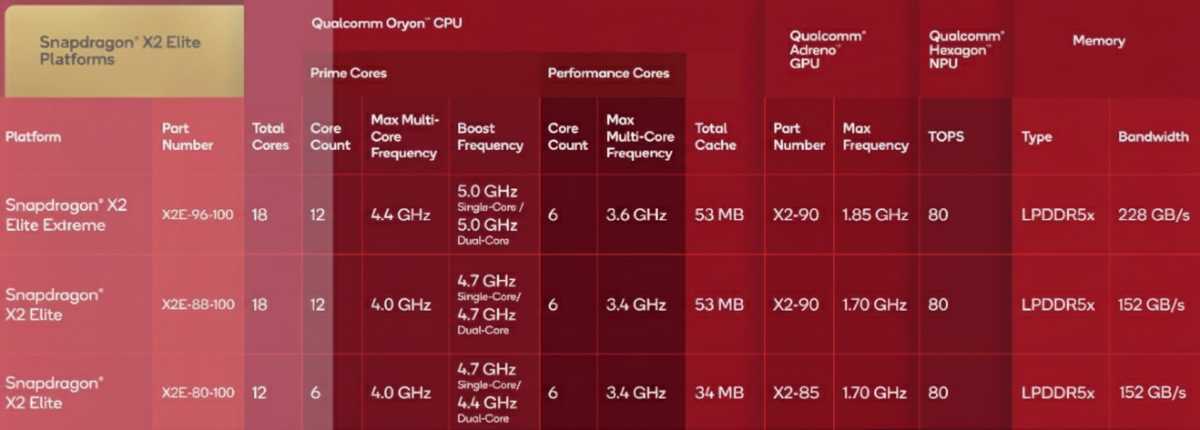
A summary of Qualcomm’s new Snapdragon X2 Elite and X2 Elite Extreme chips.
Qualcomm
Now, things have changed. The Snapdragon X2 Elite and the Elite Extreme include both what Qualcomm calls Oryon Prime cores as well as Oryon Performance cores. The company isn’t emphasizing this, but the X2 Elite chips also include integrated memory — a whopping 48GB inside the X2 Elite Extreme.
The Prime cores are key to the 5GHz clock speed, while the Performance cores are “tuned to provide premium responsiveness and user experiences in everyday workloads with extreme power efficiency.” Presumably, these function similarly to the “performance” and “efficiency” cores in Intel’s Core Ultra Meteor Lake and Lunar Lake chips.
A combination of various factors — the GPU and CPU clock speeds and core count, as well as the memory speeds — are what differentiate Qualcomm’s Snapdragon X2 Elite from the Snapdragon X2 Elite Extreme.
What makes the Snapdragon X2 Elite Extreme different than the X2 Elite? According to a Qualcomm representative, it’s a combination of factors, including CPU and GPU clock speeds, memory, and core count. It appears the difference is memory speeds: 228GB/s for the X2 Elite Extreme via a 192-bit memory bus, and 152GB/s via a 128-bit bus for the Elite. All three chips connect to LPDDR5x memory.
Integrating memory on the package is an interesting choice. Intel pursued that strategy with its Core Ultra Series 1 chip, Meteor Lake, then gave it up because embedding a fixed amount of memory didn’t allow its customers to differentiate their products. Intel’s chief executive at the time, Pat Gelsinger, called “Meteor Lake” a “one off” and a niche product, one that was forced into the spotlight because of AI.
Right now, we don’t know why Qualcomm chose this course as well. But there’s a twist: only the Snapdragon X2 Elite Extreme has a fixed 48GB of integrated memory. The other two chips will embed ‘device-specific’ amounts of RAM, Qualcomm says, almost implying that the company will be designing custom processors.
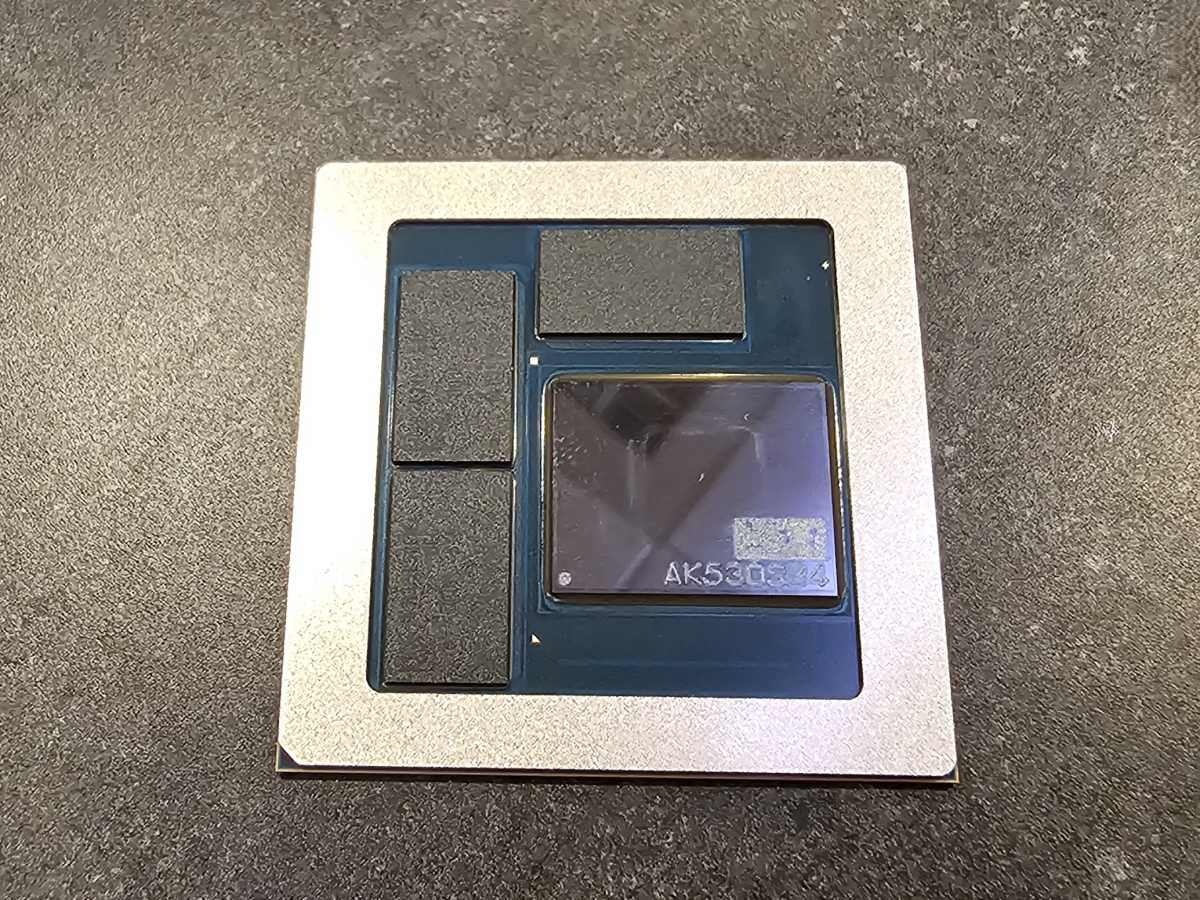
Qualcomm’s Snapdragon X2 Elite Extreme, showing the embedded memory.
Mark Hachman / Foundry
Qualcomm hasn’t clarified if the RAM will be usable as GPU VRAM, which matters because more VRAM generally supports more complex AI models. Cristiano Amon delivered a “vision” speech Tuesday night discussing the ubiquity of AI across various devices.
Eventually, Qualcomm will probably follow with derivatives for cheaper, less powerful PCs.
In April and September 2024, Qualcomm added the eight core and 10-core Snapdragon X Plus variants, with only the smaller chip graced with turbo capability. Those chips topped out at 3.4GHz, with turbo speeds up to 4GHz. In January 2025, Qualcomm tacked on the Snapdragon X, its lowest-cost offering for laptops under $600, with eight cores and speeds up to 3.0 GHz. So far, however, Qualcomm hasn’t said anything about those, nor how they would be architected.
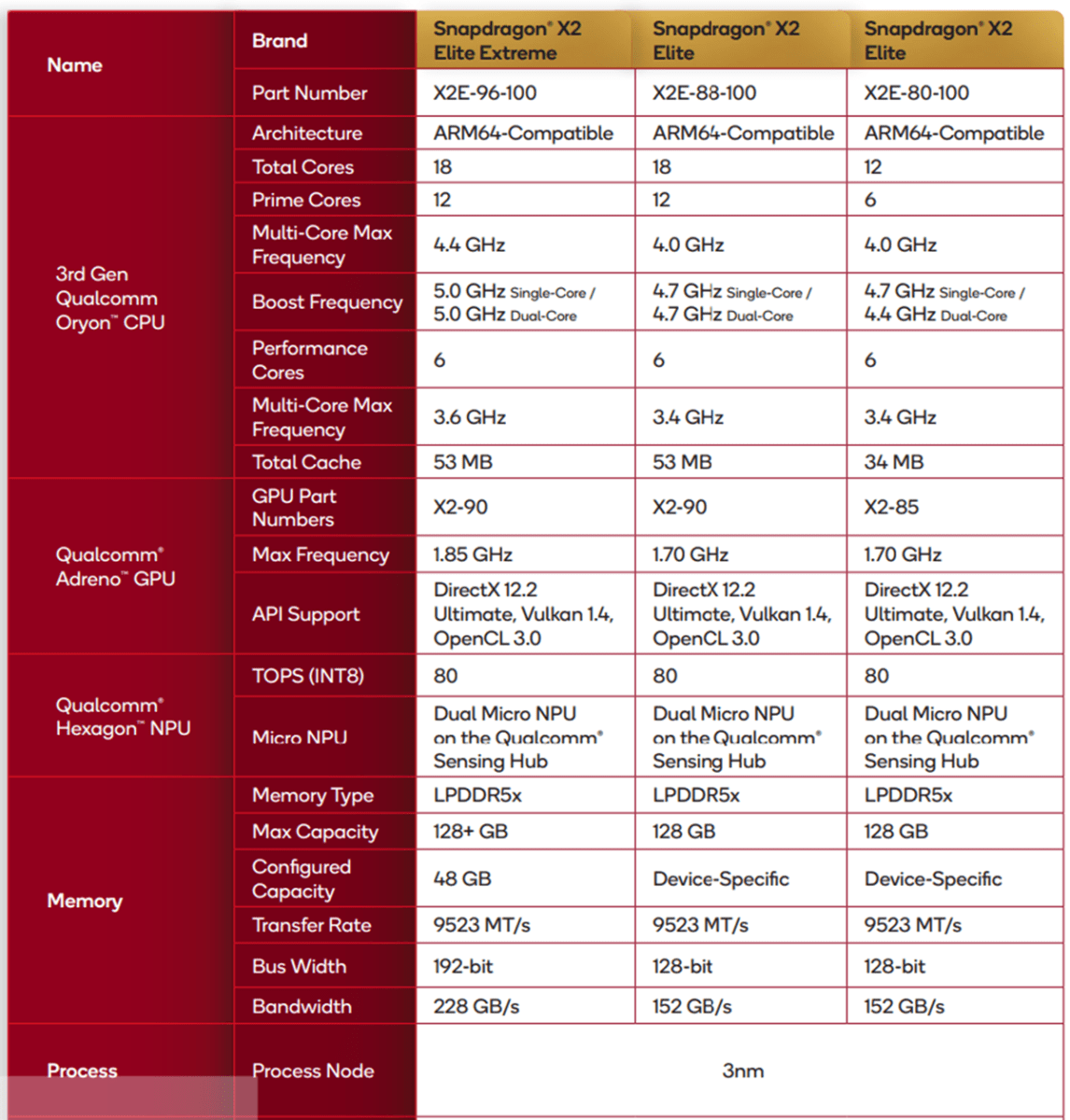
Qualcomm’s Snapdragon X2 Elite and Elite Extreme specifications, in greater detail.
Qualcomm
Snapdragon X2 Elite Extreme is tops in TOPS
Kedar Kondap, the senior vice president of compute and gaming, has said that he doesn’t particularly like the term “NPU,” since it focuses attention on a number rather than the AI experiences that accompany it. Within Qualcomm’s smartphone business, AI applications have been around for a decade, Kondap said; they include bokeh, various types of filters, and portrait mode. Within the PC space, selling the need for local AI has been a tougher battle.
Qualcomm hasn’t made it easy on itself, either. Since the new Snapdragon X Elite chips have a whopping 80 TOPS — about twice the TOPS requirement of Copilot+ PCs — Qualcomm will have to, well, redouble its efforts to convince PC makers that such a powerful NPU is needed. First-generation Snapdragon X Elites would combine AI experiences, including Windows Studio Effects and others, and without even fully saturating the NPU.
Basically, Qualcomm has yet to find the killer app for local AI — and Microsoft’s nominee, Microsoft Recall, has struggled to the point of near irrelevance. However, Adobe and Qualcomm scored one win, stating that Adobe has now optimized many of its apps for work on Qualcomm CPUs and NPUs,
Maxon Cinema 3D and ZBrush will also be optimized for Qualcomm by spring of 2026. Ableton Live, a music production tool, will also release a Snapdragon-optimized preview early next year.
Behind the scenes, however, are local AI applications consumers don’t see, including updates to Phi Silica, Microsoft’s small language model for Copilot PCs. Adobe Premiere Pro and Blender can leverage the NPU for specific functions, in addition to the software’s work with the CPU and the GPU. But the applications still have to be specifically coded for NPUs, because of the absence of Microsoft’s Windows ML.
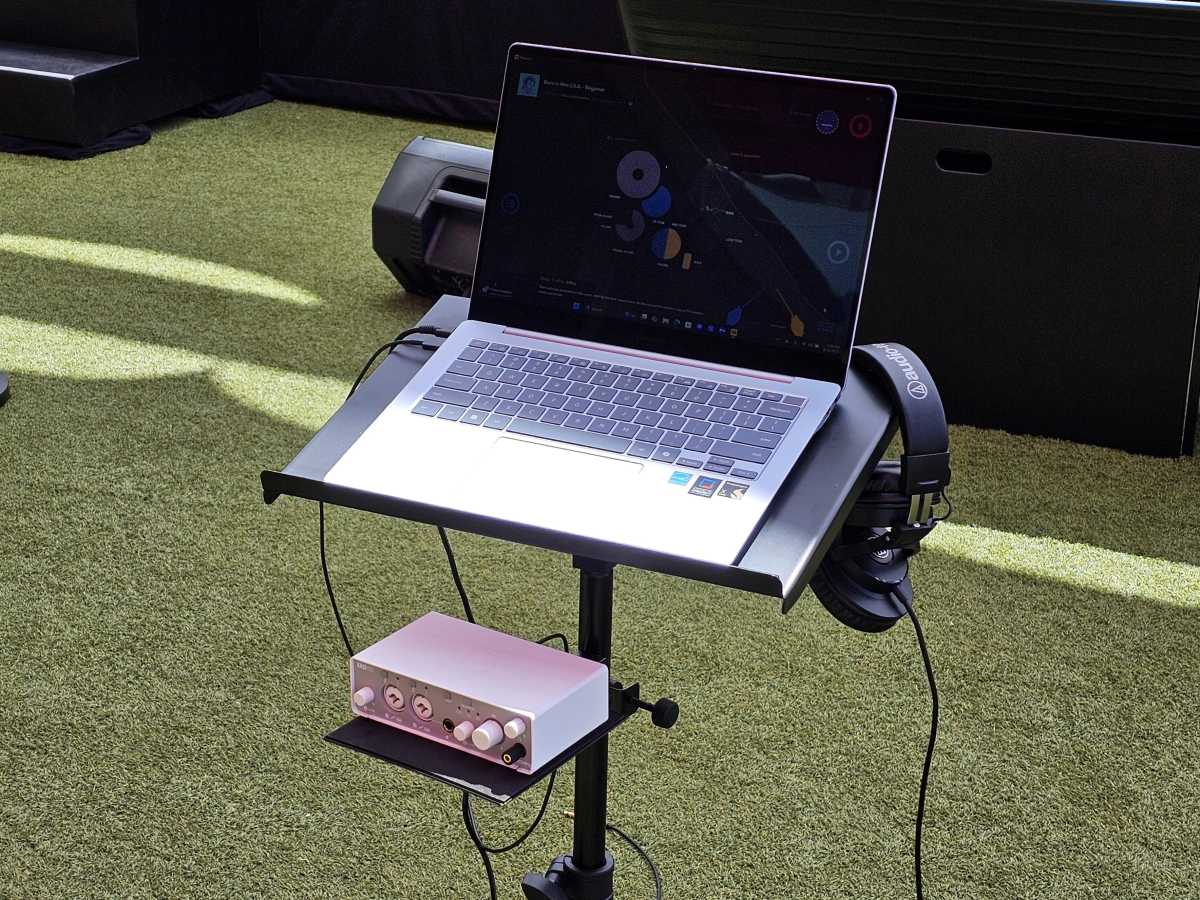
One of the few experiences I saw at the Qualcomm Snapdragon Technology Summit (at press time) included this demo where users could play an instrument, then mix it in the laptop.
Mark Hachman / Foundry
“It’s not like you’re going to get this one app that needs those 80 TOPS, right, but if you’ve got 10 things running and each take 5 [TOPS], all of a sudden you’re at 50,” said Bob O’Donnell, president of TECHnalysis Reseach. “That could be discrete apps, but it might be individual agents working on your behalf.”
Windows ML does the hard work of assigning the AI workload to the proper piece of silicon, which should help. “Windows ML is the built-in AI inferencing runtime optimized for on-device model inference and streamlined model dependency management across CPUs, GPUs and NPUs,” Microsoft says.
The good news? After first being announced in 2018, Windows ML is now available, Microsoft said Tuesday.
The Elite X2’s integrated modem may be its hidden treasure
Qualcomm isn’t saying much about the Adreno graphics core inside of the Snapdragon X2 Elite family. The company says it offers a “2.3X increase in performance per watt and power efficiency over the previous generation,” and that’s about it. The X2 Elite Extreme chip will feature the X2-90 core running at 1.85GHz; the top X2 Elite chip will also feature the X2-90, but at 1.70GHz. The slowest X2 Elite, the X2E-80-100, will include a slower X2-85 at 1.70GHz.
The Adreno core supports AV1, HEVC, and AVC decoding at dual 8K at 60 fps for all three chips. But Qualcomm’s GPU still doesn’t allow for an external GPU connection, meaning that the gaming market is largely out of reach (again).
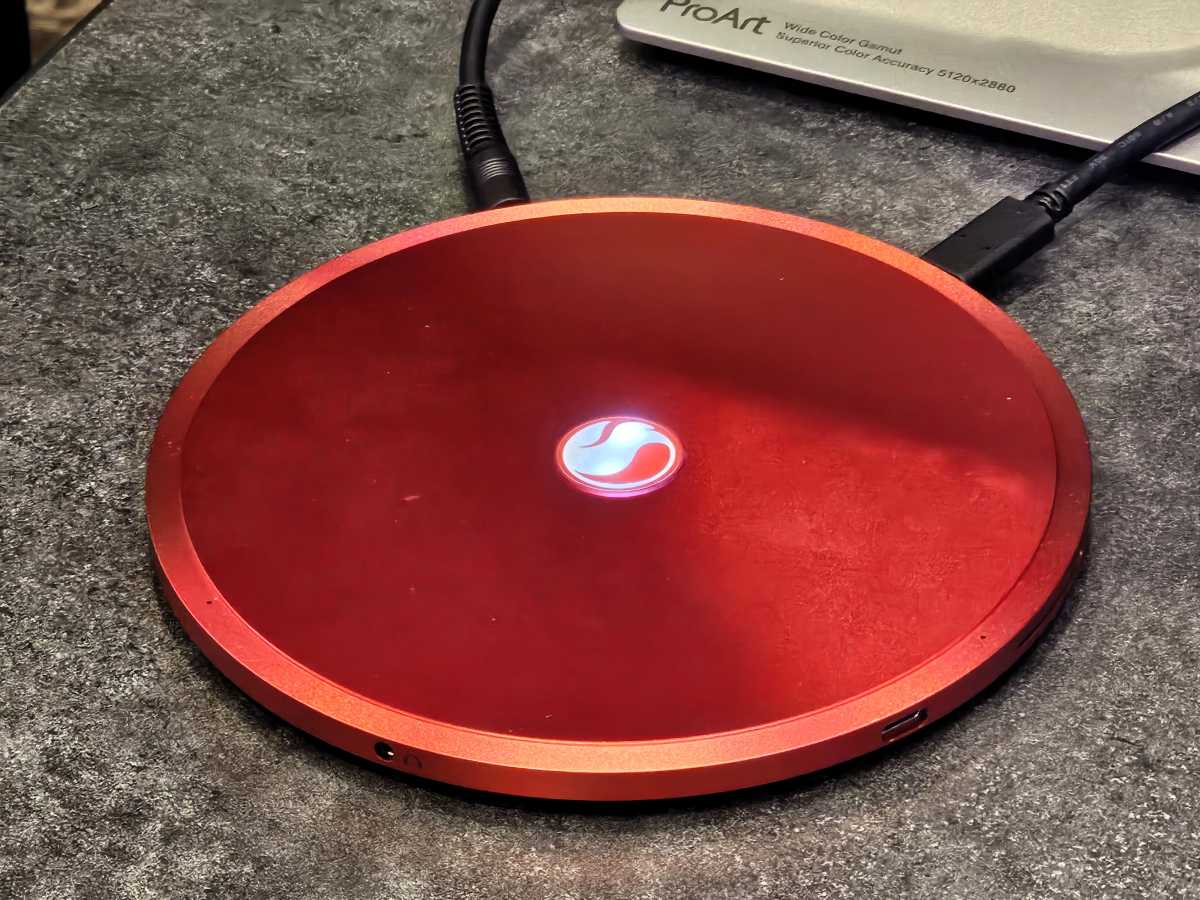
Is it a Snapdragon desktop PC? Probaby not, but this frisbee-shaped reference design is still pretty neat.
Mark Hachman / Foundry
It’s not clear how this will translate into the real world. In our extensive Snapdragon X Elite review, we didn’t really focus on gaming. However, when testing Intel’s Core Ultra Lunar Lake chip, I tested the original X Elite on a pair of games and they weren’t really playable.
Qualcomm did say, however, that gaming performance has about doubled (2.2X) from the previous generation, on titles like Grand Theft Auto V, Shadow of the Tomb Raider and Cyberpunk: 2077. The company didn’t release frame rates, however, or state what resolution or image quality it was being shot on.
To Jim McGregor, the founder of Tirias Research, the integration of Qualcomm’s X75 modem into the X2 Elite platform might be the most unexpectedly significant addition Qualcomm made. Even though the company’s mobile platforms for handsets include CPU, graphics, and modem technology, the Snapdragon X Elite platform never included it. The X2 Elite does.
“When they first came out with the embedded modem, I loved that device,” McGregor said, adding that he hoped Qualcomm would lean more into its connectivity advantage. “The fact that carriers wouldn’t support it was a pain in the butt.”
“They make the best modems in the world, literally,” O’Donnell said. “So why not make that part of the platform?”
Qualcomm calls the X75 “the world’s first Modem-RF System ready for 5G Advanced,” but the real news is simply that it’s there. Phones seamlessly roam from Wi-Fi to cellular; why shouldn’t PCs? Integrating a modem allows that to happen.
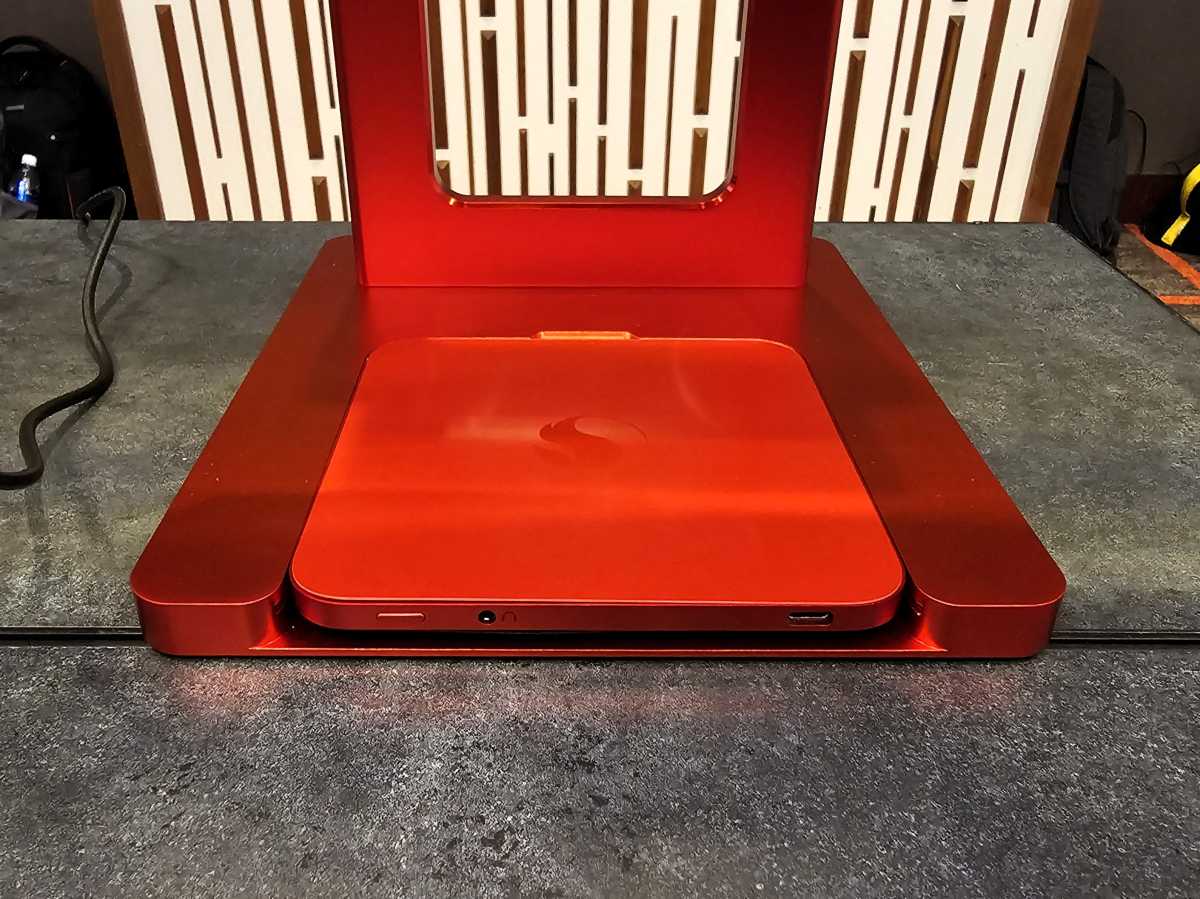
Qualcomm also showed off an “all-in-one” reference design that slots into the base of a display.
Mark Hachman / Foundry
Internally, Qualcomm says that NVMe storage is supported via dual PCI Express 5.0. Notebooks incorporating the chip will be able to support a maximum display resolution of 4K at 144Hz, or three external 4K displays at 144Hz. Since the chip only supports 40Gbps USB4 for peripherals, that probably assumes software compression of some sort.
PC makers will have 12 lanes of PCIe 5.0 to play with, except for the eight lanes usable by the slowest X2 Elite chip. Four PCIe Gen4 lanes will be available, presumably for storage.
Qualcomm has added one component to help placate corporate IT managers: Guardian, a new X2 Elite out-of-band management feature to help track and manage X2 Elite systems. That will debut in 2026, Kondap said.
Market obstacles: More of the same for Windows on Arm
Unfortunately for Qualcomm, it’s never just about the silicon.
“It’s really hard to overcome a market that’s already got mass adoption, with industry leaders” McGregor said. “Those industry leaders, especially Intel, kind of stumbled. So there was an opportunity there, right? But it’s really hard when you go in with a different architecture, different product, and you’re taking it head on.”
For all of its efforts, though, Qualcomm has yet to make a significant dent in the market. Mercury Research, which tracks CPU market share on a quarterly basis, still put AMD at about 20 percent of the notebook client PC market during the second quarter of 2025, with Intel receiving the other 80 percent. Dean McCarron, the principal analyst at Mercury, declined to specify Qualcomm’s actual market share because he was unsure of the exact sales numbers.
Qualcomm did not announce all of the PC makers who would be making laptops based on the Snapdragon X2 Elite, but Asus appeared via video to announce support, as did HP.
Qualcomm’s fundamental problem, however, is that audiences haven’t responded as well as the company might have expected. For that, one can point to any number of factors: lingering concerns about app compatibility–a problem Qualcomm aggressively tried to address; issues with Microsoft’s rollout of its Copilot+ program, including apps like Microsoft Recall; and successful launches of rival mobile chips. McGregor ticked off more: a lack of support for STEM applications and a management solution for enterprise.
In PCWorld tests, Qualcomm came out on top in terms of battery life, but AMD’s CPU performance exceeded the competition. Intel’s Core Ultra Series 2 (Lunar Lake) was arguably the overall winner, combining good CPU performance, very good GPU performance, and competitive battery life versus the other two chips.
Consumers also tend to equate “AI” with ChatGPT rather than Copilot. In 2024, shipments of all Copilot+ PCs were abysmal: less than one percent of the market in 2024 and less than two percent during the first quarter of 2025.
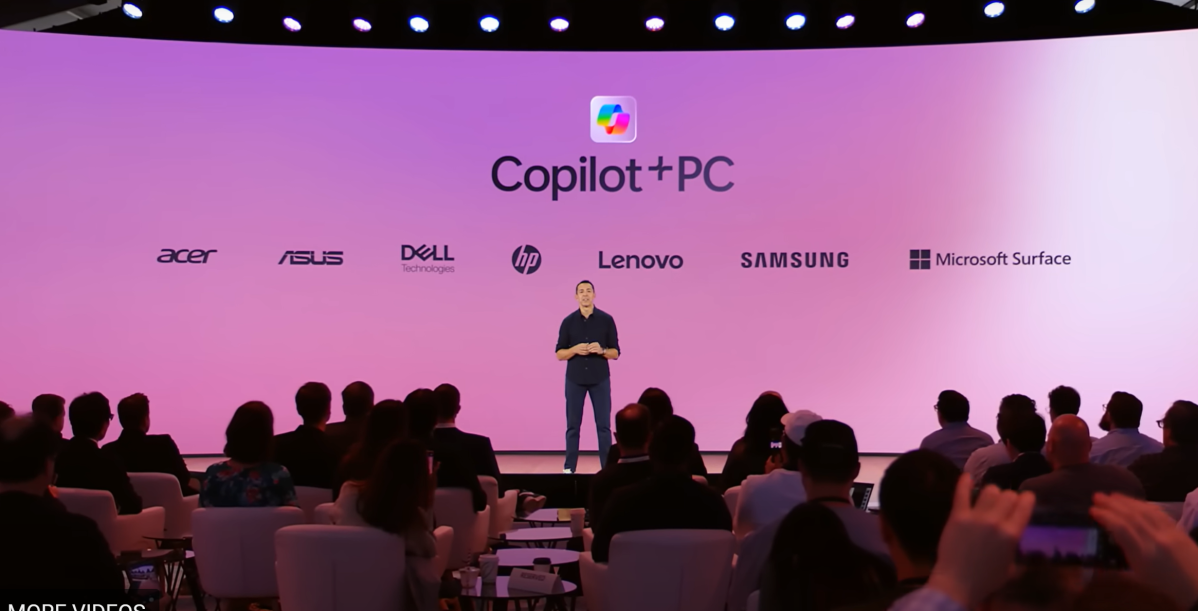
Though Microsoft launched the Copilot+ platform as a whole, it was largely oriented around Qualcomm and its first-generation Snapdragon X Elite.
YouTube / Microsoft
“I think what one of the biggest problems is that Qualcomm was strictly tied to and associated with Copilot, and it was honestly more of a Copilot issue than necessarily a Qualcomm issue,” O’Donnell said. “So I think that one of the challenges was that there was that very strong association that [Microsoft and Qualcomm] both thought was going to propel them to a higher place. Unfortunately, Recall is a real problem, and now we’re at the point where I don’t think anybody cares about Recall.”
PC makers also welcomed the competition Qualcomm’s first X Elite chip introduced… then used it as leverage in negotiations with Intel and AMD (according to one source). In the United States, just nine shipping products currently include a first-generation Snapdragon X Elite chip, a source said. (On stage, Kondap said that over 150 Snapdragon X Elite platforms have shipped globally.) By contrast, 224 Intel systems and 106 mobile PCs use AMD’s chips, and Qualcomm’s market share is still quite small.
Kedar Kondap, Qualcomm’s general manager of compute and gaming, doesn’t see it that way. In an interview before the launch, he pointed out that Qualcomm’s sales in its first year exceeded AMD and Intel in their own. At Qualcomm’s analyst day, Qualcomm chief executive Cristiano Amon put forward a target: $4 billion in sales by 2029, Kondap said. That’s years away, evidence that Qualcomm is playing the long game with its Snapdragon processors.
“You have to give them credit because I lose track of this myself — they’ve only been in the market for 15 months,” O’Donnell said. “For 15 months, it’s not too shabby.”
Disclosure: Qualcomm paid for my room, board, and travel expenses, but did not ask for or exert any editorial control over this story or other PCWorld content. Updated at 11:49 AM local time.
Author: Mark Hachman, Senior Editor, PCWorld

Mark has written for PCWorld for the last decade, with 30 years of experience covering technology. He has authored over 3,500 articles for PCWorld alone, covering PC microprocessors, peripherals, and Microsoft Windows, among other topics. Mark has written for publications including PC Magazine, Byte, eWEEK, Popular Science and Electronic Buyers' News, where he shared a Jesse H. Neal Award for breaking news. He recently handed over a collection of several dozen Thunderbolt docks and USB-C hubs because his office simply has no more room.
Recent stories by Mark Hachman:
Image: Mark Hachman / Foundry
On Wednesday, Qualcomm announced three new Snapdragon X2 Elite and X2 Elite Extreme processors for PCs, pushing into what it calls ‘ultra-premium PCs’ with a 5GHz CPU and an NPU delivering an industry-leading 80 TOPS.
Qualcomm made a name for itself with all-day battery life, but its new “multi-day” battery life received little mention in the context of the X2 Elite chips for Windows on Arm PCs.
Now, it’s all about speed: the X2 Elite platform delivers 31 percent more performance than the X1 Elite at the same power, or the same performance at 43 percent less power. That’s helped by a move to 3nm versus the 4nm platform of the first Snapdragon X Elite.
There are also some notable differences in Qualcomm’s updated CPU architecture. The Snapdragon X2 Elite incorporates third-generation Oryon CPU cores, and more of them: up to 18 in total, subdivided between a new “prime core” and a new “performance core,” which the first-gen X Elite ignored. Qualcomm even took a page from Intel and integrated memory on package, up to a whopping 48GB inside the X2 Elite Extreme. Finally, Qualcomm integrated its X75 5G modem, an unexpectedly significant addition.
Qualcomm launched the two chip families at its Qualcomm Snapdragon Summit in Maui, where company executives said that the first PCs designed around the Snapdragon X2 Elite will ship in the first half of 2026. This aligns with the typical launch schedules of rivals AMD and Intel, who work with their own notebook customers to release products based on their chips.
“It’s not just a chip, it’s a revolution,” Kedar Kondap, Qualcomm’s senior vice president in charge of the X2 Elite, said in introducing the chip at the Snapdragon Summit.

Demo laptops used to show off Qualcomm’s Snapdragon X2 Elite.
Mark Hachman / Foundry
What are the features of the Snapdragon X2 Elite and Elite Extreme?
Qualcomm is shipping three new members of its Qualcomm Snapdragon X2 Elite platforms: the X2E-96-100, the X2E-88-100, and the X2E-80-100. Instead of using these impenetrable product names, think of them this way:
- Snapdragon X2 Elite Extreme: 18 total cores, 12 prime cores (4.4GHz all cores sustained/5.0GHz boost), and six performance cores (3.6GHz sustained, no boost)
- Snapdragon X2 Elite: 18 total cores, 12 prime cores (4.0GHz sustained/4.7GHz boost), and six performance cores (3.4GHz sustained)
- Snapdragon X2 Elite: 12 total cores, six prime cores (4.0GHz sustained/4.4-4.7GHz boost), and six performance cores (3.4GHz sustained)
The Qualcomm Oryon cores inside the first-generation Snapdragon X Elite were all based on the Arm architecture, though the company’s license allows it to design a “clean sheet” microprocessor as long as it remains compatible with Arm instructions. Unlike Arm, which now uses four different CPU cores in its Lumex processor, the first-generation X Elite chose one type: all 12 cores were performance cores running at full speed, even on battery. The base clock speed of the was 3.8GHz, with a turbo speed of 4.3 GHz.

A summary of Qualcomm’s new Snapdragon X2 Elite and X2 Elite Extreme chips.
Qualcomm
Now, things have changed. The Snapdragon X2 Elite and the Elite Extreme include both what Qualcomm calls Oryon Prime cores as well as Oryon Performance cores. The company isn’t emphasizing this, but the X2 Elite chips also include integrated memory — a whopping 48GB inside the X2 Elite Extreme.
The Prime cores are key to the 5GHz clock speed, while the Performance cores are “tuned to provide premium responsiveness and user experiences in everyday workloads with extreme power efficiency.” Presumably, these function similarly to the “performance” and “efficiency” cores in Intel’s Core Ultra Meteor Lake and Lunar Lake chips.
A combination of various factors — the GPU and CPU clock speeds and core count, as well as the memory speeds — are what differentiate Qualcomm’s Snapdragon X2 Elite from the Snapdragon X2 Elite Extreme.
What makes the Snapdragon X2 Elite Extreme different than the X2 Elite? According to a Qualcomm representative, it’s a combination of factors, including CPU and GPU clock speeds, memory, and core count. It appears the difference is memory speeds: 228GB/s for the X2 Elite Extreme via a 192-bit memory bus, and 152GB/s via a 128-bit bus for the Elite. All three chips connect to LPDDR5x memory.
Integrating memory on the package is an interesting choice. Intel pursued that strategy with its Core Ultra Series 1 chip, Meteor Lake, then gave it up because embedding a fixed amount of memory didn’t allow its customers to differentiate their products. Intel’s chief executive at the time, Pat Gelsinger, called “Meteor Lake” a “one off” and a niche product, one that was forced into the spotlight because of AI.
Right now, we don’t know why Qualcomm chose this course as well. But there’s a twist: only the Snapdragon X2 Elite Extreme has a fixed 48GB of integrated memory. The other two chips will embed ‘device-specific’ amounts of RAM, Qualcomm says, almost implying that the company will be designing custom processors.

Qualcomm’s Snapdragon X2 Elite Extreme, showing the embedded memory.
Mark Hachman / Foundry
Qualcomm hasn’t clarified if the RAM will be usable as GPU VRAM, which matters because more VRAM generally supports more complex AI models. Cristiano Amon delivered a “vision” speech Tuesday night discussing the ubiquity of AI across various devices.
Eventually, Qualcomm will probably follow with derivatives for cheaper, less powerful PCs.
In April and September 2024, Qualcomm added the eight core and 10-core Snapdragon X Plus variants, with only the smaller chip graced with turbo capability. Those chips topped out at 3.4GHz, with turbo speeds up to 4GHz. In January 2025, Qualcomm tacked on the Snapdragon X, its lowest-cost offering for laptops under $600, with eight cores and speeds up to 3.0 GHz. So far, however, Qualcomm hasn’t said anything about those, nor how they would be architected.

Qualcomm’s Snapdragon X2 Elite and Elite Extreme specifications, in greater detail.
Qualcomm
Snapdragon X2 Elite Extreme is tops in TOPS
Kedar Kondap, the senior vice president of compute and gaming, has said that he doesn’t particularly like the term “NPU,” since it focuses attention on a number rather than the AI experiences that accompany it. Within Qualcomm’s smartphone business, AI applications have been around for a decade, Kondap said; they include bokeh, various types of filters, and portrait mode. Within the PC space, selling the need for local AI has been a tougher battle.
Qualcomm hasn’t made it easy on itself, either. Since the new Snapdragon X Elite chips have a whopping 80 TOPS — about twice the TOPS requirement of Copilot+ PCs — Qualcomm will have to, well, redouble its efforts to convince PC makers that such a powerful NPU is needed. First-generation Snapdragon X Elites would combine AI experiences, including Windows Studio Effects and others, and without even fully saturating the NPU.
Basically, Qualcomm has yet to find the killer app for local AI — and Microsoft’s nominee, Microsoft Recall, has struggled to the point of near irrelevance. However, Adobe and Qualcomm scored one win, stating that Adobe has now optimized many of its apps for work on Qualcomm CPUs and NPUs,
Maxon Cinema 3D and ZBrush will also be optimized for Qualcomm by spring of 2026. Ableton Live, a music production tool, will also release a Snapdragon-optimized preview early next year.
Behind the scenes, however, are local AI applications consumers don’t see, including updates to Phi Silica, Microsoft’s small language model for Copilot PCs. Adobe Premiere Pro and Blender can leverage the NPU for specific functions, in addition to the software’s work with the CPU and the GPU. But the applications still have to be specifically coded for NPUs, because of the absence of Microsoft’s Windows ML.

One of the few experiences I saw at the Qualcomm Snapdragon Technology Summit (at press time) included this demo where users could play an instrument, then mix it in the laptop.
Mark Hachman / Foundry
“It’s not like you’re going to get this one app that needs those 80 TOPS, right, but if you’ve got 10 things running and each take 5 [TOPS], all of a sudden you’re at 50,” said Bob O’Donnell, president of TECHnalysis Reseach. “That could be discrete apps, but it might be individual agents working on your behalf.”
Windows ML does the hard work of assigning the AI workload to the proper piece of silicon, which should help. “Windows ML is the built-in AI inferencing runtime optimized for on-device model inference and streamlined model dependency management across CPUs, GPUs and NPUs,” Microsoft says.
The good news? After first being announced in 2018, Windows ML is now available, Microsoft said Tuesday.
The Elite X2’s integrated modem may be its hidden treasure
Qualcomm isn’t saying much about the Adreno graphics core inside of the Snapdragon X2 Elite family. The company says it offers a “2.3X increase in performance per watt and power efficiency over the previous generation,” and that’s about it. The X2 Elite Extreme chip will feature the X2-90 core running at 1.85GHz; the top X2 Elite chip will also feature the X2-90, but at 1.70GHz. The slowest X2 Elite, the X2E-80-100, will include a slower X2-85 at 1.70GHz.
The Adreno core supports AV1, HEVC, and AVC decoding at dual 8K at 60 fps for all three chips. But Qualcomm’s GPU still doesn’t allow for an external GPU connection, meaning that the gaming market is largely out of reach (again).

Is it a Snapdragon desktop PC? Probaby not, but this frisbee-shaped reference design is still pretty neat.
Mark Hachman / Foundry
It’s not clear how this will translate into the real world. In our extensive Snapdragon X Elite review, we didn’t really focus on gaming. However, when testing Intel’s Core Ultra Lunar Lake chip, I tested the original X Elite on a pair of games and they weren’t really playable.
Qualcomm did say, however, that gaming performance has about doubled (2.2X) from the previous generation, on titles like Grand Theft Auto V, Shadow of the Tomb Raider and Cyberpunk: 2077. The company didn’t release frame rates, however, or state what resolution or image quality it was being shot on.
To Jim McGregor, the founder of Tirias Research, the integration of Qualcomm’s X75 modem into the X2 Elite platform might be the most unexpectedly significant addition Qualcomm made. Even though the company’s mobile platforms for handsets include CPU, graphics, and modem technology, the Snapdragon X Elite platform never included it. The X2 Elite does.
“When they first came out with the embedded modem, I loved that device,” McGregor said, adding that he hoped Qualcomm would lean more into its connectivity advantage. “The fact that carriers wouldn’t support it was a pain in the butt.”
“They make the best modems in the world, literally,” O’Donnell said. “So why not make that part of the platform?”
Qualcomm calls the X75 “the world’s first Modem-RF System ready for 5G Advanced,” but the real news is simply that it’s there. Phones seamlessly roam from Wi-Fi to cellular; why shouldn’t PCs? Integrating a modem allows that to happen.

Qualcomm also showed off an “all-in-one” reference design that slots into the base of a display.
Mark Hachman / Foundry
Internally, Qualcomm says that NVMe storage is supported via dual PCI Express 5.0. Notebooks incorporating the chip will be able to support a maximum display resolution of 4K at 144Hz, or three external 4K displays at 144Hz. Since the chip only supports 40Gbps USB4 for peripherals, that probably assumes software compression of some sort.
PC makers will have 12 lanes of PCIe 5.0 to play with, except for the eight lanes usable by the slowest X2 Elite chip. Four PCIe Gen4 lanes will be available, presumably for storage.
Qualcomm has added one component to help placate corporate IT managers: Guardian, a new X2 Elite out-of-band management feature to help track and manage X2 Elite systems. That will debut in 2026, Kondap said.
Market obstacles: More of the same for Windows on Arm
Unfortunately for Qualcomm, it’s never just about the silicon.
“It’s really hard to overcome a market that’s already got mass adoption, with industry leaders” McGregor said. “Those industry leaders, especially Intel, kind of stumbled. So there was an opportunity there, right? But it’s really hard when you go in with a different architecture, different product, and you’re taking it head on.”
For all of its efforts, though, Qualcomm has yet to make a significant dent in the market. Mercury Research, which tracks CPU market share on a quarterly basis, still put AMD at about 20 percent of the notebook client PC market during the second quarter of 2025, with Intel receiving the other 80 percent. Dean McCarron, the principal analyst at Mercury, declined to specify Qualcomm’s actual market share because he was unsure of the exact sales numbers.
Qualcomm did not announce all of the PC makers who would be making laptops based on the Snapdragon X2 Elite, but Asus appeared via video to announce support, as did HP.
Qualcomm’s fundamental problem, however, is that audiences haven’t responded as well as the company might have expected. For that, one can point to any number of factors: lingering concerns about app compatibility–a problem Qualcomm aggressively tried to address; issues with Microsoft’s rollout of its Copilot+ program, including apps like Microsoft Recall; and successful launches of rival mobile chips. McGregor ticked off more: a lack of support for STEM applications and a management solution for enterprise.
In PCWorld tests, Qualcomm came out on top in terms of battery life, but AMD’s CPU performance exceeded the competition. Intel’s Core Ultra Series 2 (Lunar Lake) was arguably the overall winner, combining good CPU performance, very good GPU performance, and competitive battery life versus the other two chips.
Consumers also tend to equate “AI” with ChatGPT rather than Copilot. In 2024, shipments of all Copilot+ PCs were abysmal: less than one percent of the market in 2024 and less than two percent during the first quarter of 2025.

Though Microsoft launched the Copilot+ platform as a whole, it was largely oriented around Qualcomm and its first-generation Snapdragon X Elite.
YouTube / Microsoft
“I think what one of the biggest problems is that Qualcomm was strictly tied to and associated with Copilot, and it was honestly more of a Copilot issue than necessarily a Qualcomm issue,” O’Donnell said. “So I think that one of the challenges was that there was that very strong association that [Microsoft and Qualcomm] both thought was going to propel them to a higher place. Unfortunately, Recall is a real problem, and now we’re at the point where I don’t think anybody cares about Recall.”
PC makers also welcomed the competition Qualcomm’s first X Elite chip introduced… then used it as leverage in negotiations with Intel and AMD (according to one source). In the United States, just nine shipping products currently include a first-generation Snapdragon X Elite chip, a source said. (On stage, Kondap said that over 150 Snapdragon X Elite platforms have shipped globally.) By contrast, 224 Intel systems and 106 mobile PCs use AMD’s chips, and Qualcomm’s market share is still quite small.
Kedar Kondap, Qualcomm’s general manager of compute and gaming, doesn’t see it that way. In an interview before the launch, he pointed out that Qualcomm’s sales in its first year exceeded AMD and Intel in their own. At Qualcomm’s analyst day, Qualcomm chief executive Cristiano Amon put forward a target: $4 billion in sales by 2029, Kondap said. That’s years away, evidence that Qualcomm is playing the long game with its Snapdragon processors.
“You have to give them credit because I lose track of this myself — they’ve only been in the market for 15 months,” O’Donnell said. “For 15 months, it’s not too shabby.”
Disclosure: Qualcomm paid for my room, board, and travel expenses, but did not ask for or exert any editorial control over this story or other PCWorld content. Updated at 11:49 AM local time.
Author: Mark Hachman, Senior Editor, PCWorld

Mark has written for PCWorld for the last decade, with 30 years of experience covering technology. He has authored over 3,500 articles for PCWorld alone, covering PC microprocessors, peripherals, and Microsoft Windows, among other topics. Mark has written for publications including PC Magazine, Byte, eWEEK, Popular Science and Electronic Buyers' News, where he shared a Jesse H. Neal Award for breaking news. He recently handed over a collection of several dozen Thunderbolt docks and USB-C hubs because his office simply has no more room.
Recent stories by Mark Hachman:
